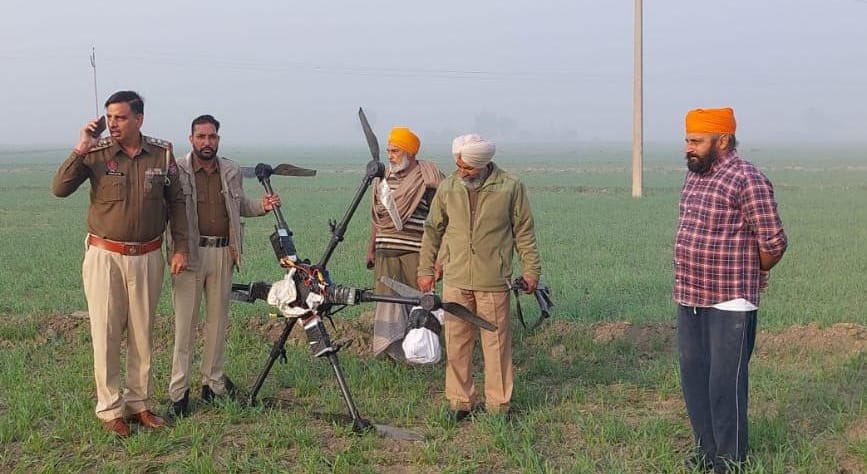
The number of drones coming from Pakistan into Indian territories have increased manifold in the last one year. While only five drones were shot down in the three-year period between 2019-2021, but this year, more than 15 drones have been shot in 11 months, writes Rajendra Khatry
Frequent drone incursions from Pakistan are posing a fresh security threat to India. In the last two years, drones have become the preferred mode for cross-border delivery of consignments including drugs and arms by the ISI and Pakistan-based militant groups.
According to the reports of the Intelligence Wing of the Punjab police, around 215 drone activities were noticed this year at various points near the border. In the first five days of December, as many as seven drones were reported to have trespassed into Indian territory from Pakistan.
According to the Border Security Force (BSF), drones from across the Pakistan border, used particularly for drugs and ammunition, have been witnessed on a regular basis along India’s western front. The number of such drones trying to enter Indian space has increased several times in the last couple of years.
For the last several months the Border Security Force (BSF) has been keeping a close watch and cracking down hard on Pakistan’s conspiracy of sending drugs and weapons through drones inside India.
Incidentally, the BSF has installed anti-drone systems along the India-Pakistan border to prevent drone infiltration. This system helps in jamming and shooting down the drones. The BSF is reportedly spending Rs 30 crore this year to strengthen the borders.
How serious the problem is can be gauged from the fact that besides the anti-drone systems, as many as 5,500 additional cameras are also being installed to monitor border infiltration and drone activities. No wonder a large number of drones returned without dropping the payload as they were confronted by the BSF.
According to reports, airdropping of drugs, arms and ammunition by drones continues non-stop despite many consignments being seized by the Indian security forces on the border. It was in the year 2019 when the drone activity to carry out narcotics and arms smuggling was first noticed. Since then such incursions have increased manifold.
Drone flights have increased tremendously in the last one year, according to the BSF. In fact, this frequency has doubled in number from across the Pakistan border on the western front posing a major challenge to the security forces. The versatility of the drone, which is very well known, has been posing a threat. In the past, drones have found new ways to bypass the frontiers which is worrisome indeed.
Fortunately, the BSF has established a modern laboratory at a camp in Delhi to study drone forensics. Now, the security agencies can track the flight path and even criminals’ addresses involved in illegal cross-border activity,
India has a long international border with Pakistan. The BSF guards the entire area which is across Gujarat, Rajasthan, Punjab and Jammu & Kashmir. According to information, India first established a drone repair lab at Delhi in September last year and later enhanced it to analyse the forensics of the drones shot down or recovered by it.
The BSF often deploys drone tracking teams, increases patrolling and instals drone tracking equipment at suspected border areas. But the criminals change the spot to continue their nefarious activities and start operating from some other region.
Many drones from Pakistan have been shot down in the Indian territory while carrying drugs and weapons. A women squad of the BSF recently foiled a cross-border drug-smuggling attempt in Amritsar district of Punjab by shooting down a drone, which was flying into Indian territory from Pakistan. It was carrying around 3.1 kg of narcotics.
The troops fired at the drone when they noticed it entering Indian territory, around 40 km north of Amritsar city. The BSF recovered partially damaged hexacopter aerial vehicle rotors. The drone’s weight was found to be around 18 kg. It was trying to smuggle around 3 kg of narcotics from Pakistan to India. The drug was wrapped in a polythene bag and was attached to the drone. In many similar instances the drone shot down in India by the security forces had similar bags attached to them.
Interestingly, since the year 2019, the Punjab Police have busted as many as 24 terror modules resulting in the recovery of a huge number of terror-related hardware, narcotics, and foreign currency. These had been reportedly sent through drones from Pakistan.
According to sources in the Punjab police, only five drones were shot down in the three-year period between 2019-2021, but this year, more than 15 drones have been shot in 11 months. The problem is such drone incursions are increasing day by day.
Most of the drones sent by Pakistan into India are Chinese-made. For example, the drone manufactured by Da-Jiang Innovations, Shenzhen, China, can carry a 9 kg weight. It has a maximum flight time of 31 minutes and its maximum speed is around 82.8 km/per hour.
There is a deep connection between the drones from Pakistan and terrorism in India. The drugs and arms sent into the Indian territories are reportedly used by the terrorists to foment trouble in India. The National Investigation Agency (NIA) recently carried out raids at 10 places in Punjab which also confirmed that gangsters turned terrorists who are operating from Pakistan are making increased use of China-made drones to send arms, ammunition and drugs across the border into Punjab.
The NIA raided the residences of several gangster-linked suspects in the border districts of Fazilka and Tarn Taran of Punjab. The suspects were found to be engaged in collecting arms and drugs supplied through the drones and passing them on to other parts of the country.
The drugs are reportedly pushed from across the border to the conduits of Khalistani terrorists in India. These conduits are said to be providing money to some modules in Punjab to perform terrorist activities. The Punjab Police suspect that the ammunition and arms used in the RPG attack on Punjab Police’s intelligence headquarters in Mohali earlier this year were also provided by the Khalistanis operating from within Pakistan who want to create trouble in India.
Pakistan has been spending a lot on these drones. A large hexacopter drone, which does not have the capacity to lift more weight, costs around Rs 14-16 lakhs in Pakistan. According to reports, to reduce the cost of the expensive Chinese drones, Pakistani smugglers have started using old drones assembled in Pakistan instead of new ones made in China to send them to India. This helps them reduce the economic loss due to the constant actions taken by the Indian security forces. Most of the drones that come from Pakistan to India are said to be made in China such as the hexacopter and quadcopter drones.













